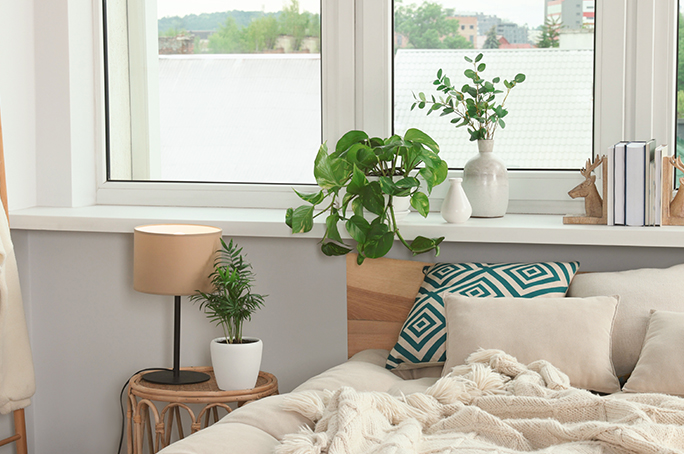Houseplants have been having a Renaissance in the past several years, with green beauties finding their homes all over the world. But while they add a touch of personality and make spaces more cozy and inviting, they can become a headache if placed randomly. Sounds confusing? Then keep reading to discover the best species for every room in your house.
Bring Focal Points to the Living Room

Where else would you proudly display your stunning collection of houseplants than in the living room? Strelitzia will wow your guests with its vibrant bird-like blooms during the flowering period, and its huge leaves will keep turning heads for the rest of the year. Just remember that it’s a tropical plant, so make sure the sunlight isn’t too bright (east- or west-facing windows will do the trick), your watering routine is regular, and humidity doesn’t drop.
Monstera deliciosa will also add a feel of a tropical rainforest to your place. But if you want its leaves to grow large and have splits in them, avoid wild guesses about the plant’s location. Bright indirect light is best, as direct sunlight can scorch the foliage. In a well-lit room, you can even put your Monstera at a bit of a distance from the windows. For healthy growth, it’ll also require high humidity and timely watering.
Ficus lyrata, Ficus elastica, and Ficus benjamina are other popular living room choices. Any of them can make a great staple plant, and as they grow fast, reaching up to 10 ft (3 m) indoors, they’ll surely grab attention. Dark-leaved Ficus varieties thrive in light shade and can be placed away from windows; variegated plants love bright light and will do best close to east- or west-facing windows. Be careful with south-facing windows, as they provide so much bright sunlight that it can burn the foliage. To avoid that, don’t forget to close the blinds on hot and sunny days.
Give the Bedroom Extra Accents

Beautiful flowers and delicate leaves of the lavender add a nice touch to the bedroom interior, while its scent has a calming effect and improves the quality of sleep. Plus, it’s not demanding in terms of care—it doesn’t need frequent watering and thrives in average humidity. Just make sure to put it on a sunny windowsill facing south or east, and you’re good to go.
Whether you decide to train Epipremnum to climb up a trellis or let it trail down from a shelf, it’ll be the green superstar of the room. To make your bedroom more cozy, you can even decorate the shoots with string lights or your favorite charms! Epipremnum is pretty low-maintenance too. Just position it near a window (or deeper in the room, if it still can get some sunlight there) and mist your plant from time to time.
Add a Pop of Color to the Nursery

Saintpaulia comes in a variety of shapes and hues, and its velvety leaves enhance their delicate beauty even more. The best part is, this plant won’t harm you or your pets, so it’s perfect for nursery windowsills with bright, diffused light. The only thing this plant is fussy about is getting its leaves wet, so it’s best to water your Saintpaulia from the bottom by pouring water into the pot saucer.
Spice up the Kitchen

Spicy herbs like basil, rosemary, mint, and cilantro not only taste good, but also complement your kitchen interior. These plants need bright light and regular watering, and high humidity will be a plus when growing them. However, be mindful of heated appliances, such as stoves or kettles—you don’t want any accidental burns.
Give a Touch of Nature to the Working Space

Even though the belief that cacti can protect you from electromagnetic radiation has been proven false a long time ago, they’re still widely loved in office environments. Choosing these small spiky beauties or succulents like Echeveria, Haworthia, and Aloe can save you the hassle of constant attention and care. Succulents store water in their leaves and shoots and don’t need frequent watering. They’re also slow-growing and won’t take up much space: a small windowsill area, a well-lit shelf or the space under a table lamp will be enough for them to thrive.
Turn the Bathroom Into a Forest

If you have windows or a grow light in the bathroom, Nephrolepis and other ferns will be fantastic plants to accommodate there. Ferns enjoy the bathroom’s humid environment, and if planted in a pot with drainage holes, you can even give them showers, watering both the soil and the foliage.
Tillandsia is very unusual—it grows without soil and absorbs water from the air. Thus, if you put it in a humid environment of a bathroom, you won’t have to worry much about taking care of it. If you decide to give it some extra love, though, you can soak your Tillandsia in water for 15–30 minutes and then return the plant to its place. And don’t forget that, just like any other plants, Tillandsia needs sunlight to thrive—make sure to provide it with bright diffused light or a little shade.
Now that you’ve learned all the secrets, let your inner designer shine and your creativity run wild. Find the perfect spot for your green darlings and enjoy their flourishing beauty!
